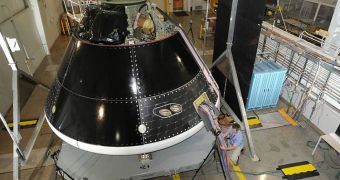Officials with the American space agency announce that NASA wants to introduce a new clause in a contract it signed with Lockheed Martin Space Systems, concerning the development of the Orion Multi-Purpose Crew Vehicle (MPCV). The agency wants the spacecraft to fly in 2014.
Lockheed engineers are in charge of designing, developing, testing and evaluating the future US space capsule, a prototype of which has already been constructed. The contract the company has with NASA already stipulates several MPCV flights, but the agency wants an extra one included in the agreement.
The new flight will be used to support the development of the Space Launch System (SLS), which is America's next heavy-lift delivery system. The rocket will be able to carry in excess of 100 tons to low-Earth orbit, and will be used to send spacecraft to the Moon, Mars and a near-Earth asteroid.
The US plans to rely on the MPCV/SLS combo for its next human spaceflight efforts. Where the Orion capsule will fail, spacecraft such as SpaceX's Dragon could be used for exploring other worlds.
“President Obama and Congress have laid out an ambitious space exploration plan, and NASA is moving out quickly to implement it,” David Weaver said in a statement. He holds an appointment as the Associate Administrator for Communications at NASA.
“This flight test will provide invaluable data to support the deep space exploration missions this nation is embarking upon,” he added. The maneuver has been designated Exploration Flight Test (EFT-1).
It will involve the MPCV completing two high-apogee orbits around the planet, before finally performing a high-energy reentry through the atmosphere. The spacecraft needs to withstand the fiery temperatures of reentry, and then make a safe splash in the ocean.
“The entry part of the test will produce data needed to develop a spacecraft capable of surviving speeds greater than 20,000 mph and safely return astronauts from beyond Earth orbit,” explained William Gerstenmaier, who is the Associate Administrator for Human Exploration and Operations at NASA.
“This test is very important to the detailed design process in terms of the data we expect to receive,” the top official added. “NASA is developing the Orion spacecraft to launch astronauts to asteroids, the moon, Mars and other destinations atop SLS, the agency's new heavy launch vehicle,” a NASA press release adds.
“An early orbital flight test such as EFT-1 will provide data needed to influence design decisions and serve as a pathfinder to validate innovative new approaches to space systems development. The goal is to reduce the cost and schedule risks of exploration missions,” the statement concludes.

 14 DAY TRIAL //
14 DAY TRIAL //